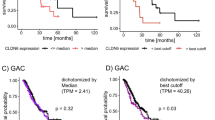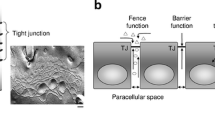Abstract
In the past few decades an enormous amount of data became known to clarify the molecular composition and architecture of tight junctions (TJs). Despite the efforts, the expression and function of several TJ genes and proteins in breast carcinoma are still not known and some of the data are contradictory. The expression of forty-four TJ associated genes was examined at mRNA level in eighteen invasive ductal breast carcinoma samples and corresponding normal breast tissues by using low density array PCR. Expressions of claudins (CLDNs) 5, 10, 16, 17, and 18, and ZO-1, ZO-2 were evaluated by immunohistochemistry as well. Using immunohistochemical phenotype as a surrogate for the genetic subtype, 11 luminal A, 3 luminal B, 3 triple negative and one HER2+ cases were included. Ten genes were significantly downregulated in tumors compared with normal breast tissues (CLDNs 5, 10, 16, 18, 19, CTNNAL1, JAM-B, ZO-1, ZO-2 and PARD3), whereas one gene (CLDN17) was significantly up-regulated in tumors when compared with normal breast. At protein level CLDNs 5, 10, 16, 18, ZO-1 and ZO-2 were downregulated in tumors as compared with normal breast tissue. CLDN17 showed variable expression in tumor tissues in comparison to normal breast. In the single HER2+ tumor when compared with the other subtypes CLDNs 5, 16, 17, 18, CTNNAL1, JAM-B, ZO-1, ZO-2 and PARD3 genes were found to be upregulated. We found altered TJ genes and proteins whose expression has not yet been associated with breast carcinoma. Our findings show a tendency of TJ genes and proteins to be downregulated in breast cancer. Further studies are necessary to examine whether the downregulation of the above mentioned TJ associated genes and proteins may contribute to the malignant progression of invasive ductal breast carcinomas.







Similar content being viewed by others
Abbreviations
- AJ-:
-
Adherens junctions
- BSA-:
-
Bovine serum albumine
- CDC42-:
-
Cell division cycle 42 (GTP binding protein, 25 kDa)
- CGN-:
-
Cingulin
- CLDN-:
-
Claudin
- CLDN1-:
-
Claudin 1
- CLDN10-:
-
Claudin 10
- CLDN11-:
-
Claudin 11 (oligodendrocyte transmembrane protein)
- CLDN12-:
-
Claudin 12
- CLDN14-:
-
Claudin 14
- CLDN15-:
-
Claudin 15
- CLDN16-:
-
Claudin 16
- CLDN17-:
-
Claudin 17
- CLDN18-:
-
Claudin 18
- CLDN19-:
-
Claudin 19
- CLDN2-:
-
Claudin 2
- CLDN20-:
-
Claudin 20
- CLDN3-:
-
Claudin 3
- CLDN4-:
-
Claudin 4
- CLDN5-:
-
Claudin 5
- CLDN6-:
-
Claudin 6
- CLDN7-:
-
Claudin 7
- CLDN8-:
-
Claudin 8
- CLDN9-:
-
Claudin 9
- CLDND2-:
-
Claudin domain containing 2
- CRB3-:
-
Crumbs homolog 3 (Drosophila)
- CTNNAL1-:
-
Catenin (cadherin-associated protein), alpha-like 1
- CTNNBIP1-:
-
Catenin, beta interacting protein 1
- DAPI-:
-
4′-6-Diamidino-2-phenylindole’
- F11R-:
-
F11 receptor
- GAPDH-:
-
Glyceraldehyde-3-phosphate dehydrogenase
- HPRT1-:
-
Hypoxanthine phosphoribosyltransferase 1
- IDC-:
-
Invasive ductal carcinoma
- JAM-B-:
-
Junctional adhesion molecule B
- JAM-C-:
-
Junctional adhesion molecule C
- MAGI1-:
-
Membrane associated guanylate kinase, WW and PDZ domain containing 1
- MAGIX-:
-
MAGI family member, X-linked
- MARK2-:
-
MAP/microtubule affinity-regulating kinase
- MLLT4-:
-
Myeloid/lymphoid or mixed-lineage leukemia (trithorax homolog, Drosophila); translocated to, 4
- MPDZ-:
-
Multiple PDZ domain protein
- MPP5-:
-
Membrane protein, palmitoylated 5 (MAGUK p55 subfamily member 5)
- OCLN-:
-
Occludin
- PARD3-:
-
par-3 partitioning defective 3 homolog
- PARD6A-:
-
par-6 partitioning defective 6 homolog alpha
- PBS-:
-
Phosphate buffered saline
- RHOA-:
-
Ras homolog gene family, member A
- RPL13A-:
-
Ribosomal protein L13a
- SDHA-:
-
Succinate dehydrogenase complex, subunit A, flavoprotein (Fp)
- SYMPK-:
-
Symplekin
- TGFB1-:
-
Transforming growth factor, beta 1
- TJ-:
-
Tight junction
- ZO-1-:
-
Tight junction protein 1 (zona occludens 1)
- ZO-2-:
-
Tight junction protein 2 (zona occludens 2)
- ZO-3-:
-
Tight junction protein 3 (zona occludens 3)
- TLDA-:
-
TaqMan Low Density Array
References
Brennan K, Offiah G, McSherry EA et al (2010) Tight junctions: a barrier to the initiation and progression of breast cancer? J Biomed Biotechnol. doi:10.1155/2010/460607
Gonzalez-Mariscal L, Betanzos A, Nava P et al (2003) Tight junction proteins. Progr Biophys Mol Biol 81:1–44
Gonzalez-Mariscal L, Lechuga S, Garay E (2007) Role of tight junctions in cell proliferation and cancer. Progr Histochem Cytochem 42:1–57
Lelievre SA (2010) Tissue polarity-dependent control of mammary epithelial homeostasis and cancer development: an epigenetic perspective. J Mammary Gland Biol Neoplasia 15:49–63
Alroy J (1979) Tight junctions adjacent to tumor stromal interface in human invasive transitional cell carcinomas. Virchows Arch 30:289–296
Martinez-Palomo A (1970) Ultrastructural modifications of intercellular junctions between tumor cells. In Vitro 6:15–20
Martinez-Palomo A (1970) Ultrastructural modifications of intercellular junctions in some epithelial tumors. Lab Investig 22:605–614
Hough CD, Sherman-Baust CA, Pizer ES et al (2000) Large-scale serial analysis of gene expression reveals genes differentially expressed in ovarian cancer. Cancer Res 60:6281–6287
Hoevel T, Macek R, Mundigl O et al (2002) Expression and targeting of the tight junction protein CLDN1 in CLDN1-negative human breast tumor cells. J Cell Physiol 191:60–68
Hoevel T, Macek R, Swisshelm K et al (2004) Reexpression of the TJ protein CLDN1 induces apoptosis in breast tumor spheroids. Int J Cancer 108:374–383
Kominsky SL, Argani P, Korz D et al (2003) Loss of the tight junction protein claudin-7 correlates with histological grade in both ductal carcinoma in situ and invasive ductal carcinoma of the breast. Oncogene 22:2021–2033
Kramer F, White K, Kubbies M et al (2000) Genomic organization of claudin-1 and its assessment in hereditary and sporadic breast cancer. Human Genet 107:249–256
Sobel G, Paska C, Szabo I et al (2005) Increased expression of claudins in cervical squamous intraepithelial neoplasia and invasive carcinoma. Human Pathol 36:162–169
Sobel G, Nemeth J, Kiss A et al (2006) Claudin 1 differentiates endometrioid and serous papillary endometrial adenocarcinoma. Gynecol Oncol 103:591–598
Blanchard AA, Skliris GP, Watson PH et al (2009) Claudins 1, 3, and 4 protein expression in ER negative breast cancer correlates with markers of the basal phenotype. Virchows Arch 454:647–656
Erin N, Wang N, Xin P et al (2009) Altered gene expression in breast cancer liver metastases. Int J Cancer 124:1503–1516
Hewitt KJ, Agarwal R, Morin PJ (2006) The claudin gene family: expression in normal and neoplastic tissues. BMC Cancer 6:186
Kim TH, Huh JH, Lee S et al (2008) Down-regulation of claudin-2 in breast carcinomas is associated with advanced disease. Histopathology 53:48–55
Kulka J, Szasz AM, Nemeth Z et al (2005) Expression of tight junction protein claudin-4 in basal-like breast carcinomas. Pathol Oncol Res 15:59–64
Lanigan F, McKiernan E, Brennan DJ et al (2009) Increased claudin-4 expression is associated with poor prognosis and high tumour grade in breast cancer. Int J Cancer 124:2088–2097
Osanai M, Murata M, Nishikiori N et al (2007) Occludin-mediated premature senescence is a fail-safe mechanism against tumorigenesis in breast carcinoma cells. Cancer Sci 98:1027–1034
Tokes AM, Kulka J, Paku S et al (2005) Claudin-1, −3 and −4 proteins and mRNA expression in benign and malignant breast lesions: a research study. Breast Cancer Res 7:296–305
Martin TA, Harrison GM, Watkins G et al (2008) Claudin-16 reduces the aggressive behavior of human breast cancer cells. J Cell Biochem 105:41–52
Naik MU, Naik TU, Suckow AT et al (2008) Attenuation of junctional adhesion molecule-A is a contributing factor for breast cancer cell invasion. Cancer Res 68:2194–2203
Naik UP, Naik MU (2008) Putting the brakes on cancer cell migration: JAM-A restrains integrin activation. Cell Adh Migr 2:249–251
Morohashi S, Kusumi T, Sato F et al (2007) Decreased expression of claudin-1 correlates with recurrence status in breast cancer. Int J Mol Med 20:139–143
Creighton CJ, Li X, Landis M et al (2009) Residual breast cancers after conventional therapy display mesenchymal as well as tumor-initiating features. PNAS 106:13820–13825
Herschkowitz JI, Simin K, Weigman VJ et al (2007) Identification of conserved gene expression features between murine mammary carcinoma models and human breast tumors. Genome Biol 8:R76
Prat A, Perou CM (2009) Mammary development meets cancer genomics. Nat Med 15:842–844
Prat A, Perou CM (2011) Deconstructing the molecular portraits of breast cancer. Mol Oncol 5:5–2331
Perou CM, Sorlie T, Eisen MB et al (2000) Molecular portraits of human breast tumours. Nature 406:747–752
Escudero-Esparza A, Jiang WG, Martin TA (2011) The Claudin family and its role in cancer and metastasis. Front Biosci 1:1069–1083
Turksen K, Troy TC (2011) Junctions gone bad: claudins and loss of the barrier in cancer. Biochim Biophys Acta 1:73–79
Dahiya N, Becker KG, Wood WH et al (2011) Claudin-7 is frequently overexpressed in ovarian cancer and promotes invasion. PLoS One 6:e22119
Amasheh S, Meiri N, Gitter AH et al (2002) Claudin-2 expression induces cation-selective channels in tight junctions of epithelial cells. J Cell Sci 115:4969–4976
Amasheh S, Schmidt T, Mahn M et al (2005) Contribution of claudin-5 to barrier properties in tight junctions of epithelial cells. Cell Tissue Res 321:89–96
Nguyen DA, Neville MC (1998) Tight junction regulation in the mammary gland. J Mammary Gland Biol Neoplasia 3:233–246
Schulzke JD, Fromm M (2009) Tight junctions: molecular structure meets function. Ann NY Acad Sci 1165:1–6
Tsukita S, Furuse M (2000) The structure and function of claudins, cell adhesion molecules at tight junctions. Ann NY Acad Sci 915:129–135
Turunen M, Talvensaari-Mattila A, Soini Y et al (2009) Claudin-5 overexpression correlates with aggressive behavior in serous ovarian adenocarcinoma. Anticancer Res 29:5185–5189
Szasz A, Tokes A, Micsinai MJ et al (2011) Prognostic significance of claudin expression changes in breast cancer with regional lymph node metastasis. Clin Exp Metastasis 28:55–63
Nemeth Z, Szasz AM, Tatrai P et al (2009) Claudin-1, −2, −3, −4, −7, −8, and −10 protein expression in biliary tract cancers. J Histochem Cytochem 57:113–121
Sanada Y, Oue N, Mitani Y et al (2006) Down-regulation of the claudin-18 gene, identified through serial analysis of gene expression data analysis, in gastric cancer with an intestinal phenotype. J Pathol 208:633–642
Hou J, Renigunta A, Gomes AS et al (2009) Claudin-16 and claudin-19 interaction is required for their assembly into tight junctions and for renal reabsorption of magnesium. PNAS 106:15350–15355
Zen K, Yasui K, Gen Y et al (2009) Defective expression of polarity protein PAR-3 gene (PARD3) in esophageal squamous cell carcinoma. Oncogene 28:2910–2918
Ding L, Ellis MJ, Li S et al (2010) Genome remodelling in a basal-like breast cancer metastasis and xenograft. Nature 464:999–1005
Acknowledgements
We thank Rigóné Káli Elvira for the careful reading of our manuscript and her valuable comments. This study was supported by grants: AVON-EAGC 2005, MKOT–GSK 2006, MKOT-GSK 2008, OTKA- 49559 (2005–2009), ETT-088-01/2009.
Competing interests
The author(s) declare that they have no financial or non-financial competing interests. They do not hold any patents relating to the content of this manuscript.
Authors’ contributions
A-MT and JK analysed the selected cases, evaluated the immunohistochemical results and wrote the article. AMSz helped in selecting the genes for TLDA and isolated RNA with A-MT. EJ carried out the immunohistochemical reactions. ZsS participated in the evaluation of the immunohistochemical reactions and in the writing of the manuscript in its final stage. LH, IAM, ZsB, IB and AZ performed surgery and provided samples. SF performed biopsy of specimens after surgery.
Author information
Authors and Affiliations
Corresponding author
Electronic Supplementary Material
Below is the link to the electronic supplementary material.
ESM. 1
The relevant literature data on TJ gene and protein expression in breast carcinomas are presented in Supplementary Table 1. The primary and secondary antibodies used for TJ protein immunodetection are presented in Supplementary Table 2 (DOC 148 kb)
Rights and permissions
About this article
Cite this article
Tőkés, AM., Szász, A.M., Juhász, É. et al. Expression of Tight Junction Molecules in Breast Carcinomas Analysed by Array PCR and Immunohistochemistry. Pathol. Oncol. Res. 18, 593–606 (2012). https://doi.org/10.1007/s12253-011-9481-9
Received:
Accepted:
Published:
Issue Date:
DOI: https://doi.org/10.1007/s12253-011-9481-9




